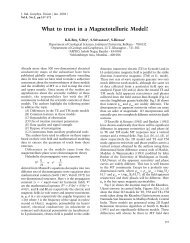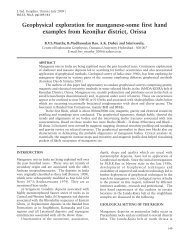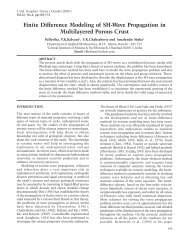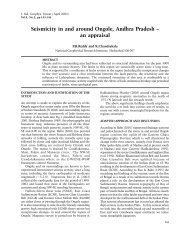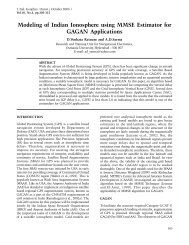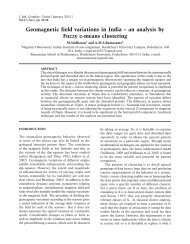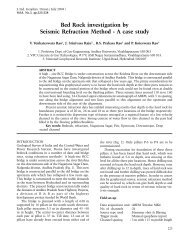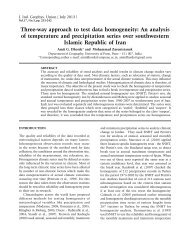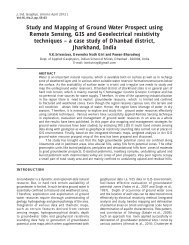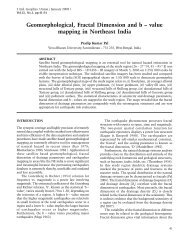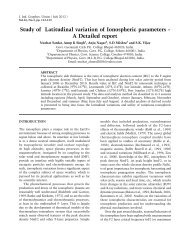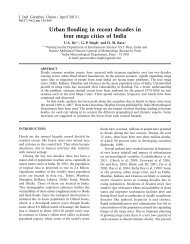Geomagnetic secular variation anomalies investigated through ... - IGU
Geomagnetic secular variation anomalies investigated through ... - IGU
Geomagnetic secular variation anomalies investigated through ... - IGU
Create successful ePaper yourself
Turn your PDF publications into a flip-book with our unique Google optimized e-Paper software.
P.B.Gawali et al.<br />
time values are not same at two stations. Day-time<br />
data in terms of micro–pulsation (Pc5) type were used<br />
in present study, which ranges between 150-600<br />
seconds (Samson 1991). Continuous string of 20<br />
values i.e., 300 seconds simultaneous data for the<br />
base and field station were selected for averaging and<br />
calculation of standard deviations. The accuracy of the<br />
estimate would certainly be improved by taking an<br />
average of 20 values. The difference was obtained by<br />
subtracting average value of base station from the<br />
average value of field station. Finally, a single value<br />
for a particular station is determined as the residual<br />
field, which can be interpreted as tectonomagnetic<br />
signal with respect to reference base station. Thus,<br />
the residuals were calculated for all field stations with<br />
respect to the reference base station for all repeated<br />
data sets. The theoretical interpretation is given as<br />
follows:<br />
On the basis of a long series of repeat total<br />
geomagnetic field surveys, <strong>anomalies</strong> of temporal<br />
geomagnetic field changes T = F, i.e.<br />
tectonomagnetic <strong>anomalies</strong> are detected within a given<br />
time interval of observations. Within the profile and<br />
spatial observations of repeat surveys following<br />
quantities were followed: Fi and Fo - total<br />
geomagnetic field intensity in the i-th point and basic<br />
point (for all points of network), respectively. If Fi*<br />
and Fo* are values for the first cycle of the<br />
observations, then ”F* = Fi* - Fo*. If Fi** and Fo**<br />
are values with a repeat cycle of the observation<br />
(within a chosen time interval, e.g. day, month, year,<br />
etc.), then ”F** = Fi** - Fo**. The tectonomagnetic<br />
anomaly is characterized by F = F* - F**. If no<br />
local changes of the field of tectonomagnetic origin<br />
occurs, then F 0 (within the measurement<br />
errors and outer field identity). The values F 0<br />
indicate the availability of recent tectonic processes,<br />
which seem to be revealed due to repeat surveys<br />
(Kuznetsova & Klymkovych 2001).<br />
RESULTS AND DISCUSSION<br />
The statistical results of the observational data show<br />
that the mean standard deviation associated with<br />
residual field T values range between 0.3 – 2 nT.<br />
The static <strong>secular</strong> <strong>variation</strong> <strong>anomalies</strong> of the<br />
geomagnetic field of the crustal origin range from ±<br />
0.1 nT/yr to ± 9.5 nT/yr at different stations in<br />
various profiles. Despite lack of any seismic event<br />
during repeat survey period, the <strong>secular</strong> <strong>variation</strong><br />
<strong>anomalies</strong> nevertheless have signified that the<br />
stresses are building in the crust of survey area. Our<br />
results seem to be reasonable compared to other<br />
66<br />
results obtained in seismoactive region of Middle Asia<br />
as shown by Shapiro et al., (1978). Much of the<br />
interpretation to follow is based on the pattern<br />
resulting from T of the annual changes at particular<br />
station by selecting some stations on each profile<br />
for the period of 2003-2009. To resolve stress related<br />
temporal magnetic changes of the crustal origin, the<br />
difference technique is used to present the results as<br />
shown in Figs. 3-7 where the residual field at each<br />
site are obtained as the difference between successive<br />
repeat surveys and are examined in space domain, i.e.<br />
with differencing second year residual field from first<br />
year and third year from second year and so on. Also<br />
the linear least-squares regression (Y= A*X +B) lines<br />
are drawn for the period 2003 to 2009 at each station<br />
in Figs. 3-7. The increase and decrease of the trends<br />
of regression lines may be judged as the increase or<br />
decrease of the level of the yearly <strong>secular</strong> changes at<br />
the station with respect to the increase or decrease<br />
of stress level.<br />
In majority of cases tectonomagnetic <strong>anomalies</strong><br />
generally show relation with earthquakes and volcanic<br />
events. However, it is suggested that the gradual<br />
crustal movement can cause stress and tension in the<br />
vicinity of faults and weaker zones resulting in the<br />
magnetization changes and the signatures can be seen<br />
on the magnetic anomaly (Sasai 1991, 1994). If the<br />
slower crustal movement develops the stress gradually,<br />
then the Central Indian crustal zone comprising NSL<br />
is most susceptible to stress development. The stress<br />
fields are due to the cumulative effects of the plate<br />
boundary forces of which the back-thrust from the<br />
Himalayan collision may be the most prominent<br />
(Gupta et al., 1997). As is shown by Oshiman (1990),<br />
spatial pattern of negative and positive changes in total<br />
geomagnetic field can also be expected on a boundary<br />
between different blocks in the direction of crustal<br />
magnetization resulting in anomalous changes in the<br />
total geomagnetic field. The <strong>anomalies</strong> in the <strong>secular</strong><br />
<strong>variation</strong>s are shown in Figs. 3-7, which is an evidence<br />
for anomalous stress distribution within the crust.<br />
In the present study we have used limited period data<br />
of the total geomagnetic field, so the electromagnetic<br />
inductions within the Earth by external sources are<br />
neglected. However, if the fluids are present in the<br />
crust, their motion is possible due to stress<br />
differentials within the crust. The fluids are capable<br />
of forcing <strong>through</strong> a porous medium thereby<br />
producing the electrokinetic charge separation. The<br />
resulting potential difference (terms a streaming<br />
potential) then causes current to flow, which is<br />
considered as electrokinetic phenomena (Mizutani et<br />
al., 1976). Hence, for the <strong>secular</strong> <strong>variation</strong> <strong>anomalies</strong>



